
5G in government The future of hyperconnected public services
19
28 August 2020
 Brian Greenberg United States
Brian Greenberg United States Rahul Bajpai United States
Rahul Bajpai United States John O'Leary United States
John O'Leary United States Mahesh Kelkar India
Mahesh Kelkar India
5G has the potential to change how government fulfills its many missions. Understanding 5G will help government officials make policy and infrastructure decisions that drive useful innovations in future.
A person in a rural area needs surgery—and soon. The nearest city hospital is almost 200 miles away, so he checks into a remote surgical facility near his home. A surgeon conducts the operation via robot, from his city office, and videoconferences with the family to provide post-op feedback.
Learn more
Explore the Government & public services collection
Learn about Deloitte's services
Go straight to smart. Get the Deloitte Insights app
A public works employee is looking for a leaking pipe underground. Using AR/VR glasses, she sees where and how deeply the pipes are buried, and so knows where to dig safely.
A firefighter responds to an emergency in a congested neighborhood. He quickly accesses the area’s public camera and drone feeds to understand the topography, then begins scanning real-time data from embedded sensors to understand the temperature and air quality before he enters the premises.
5G can make all this happen.1 It promises to deliver data 10 to 20 times faster than current 4G technology.2 It promises to provide low-latency (time to transfer a data packet) and ultra-reliable wireless connectivity.3 And it promises to do this for a huge number of devices, with densities in the range of 1 million connected devices per square kilometer.4 Unsurprisingly, consumers, businesses, and governments expect 5G to change the way we all live and work.
Why should US government officials care? First, because 5G can change how government fulfills its many missions. And second, as 5G becomes more widely implemented, government will likely be forced to make policy and operational choices that can shape our future. By understanding 5G, government officials can prepare themselves to make decisions that spur useful innovation for everyone.
Thoughtful use of 5G in government can:
- Transform government operations, providing access to unprecedented levels of real-time information from any device, anytime and anywhere, especially for field workers such as first responders, food and agricultural inspectors, law enforcement, and military personnel.
- Improve public infrastructure, creating smart, hyperconnected communities.
- Act as a force multiplier for other innovative technologies such as artificial intelligence (AI) and multiaccess edge computing (MEC), a network architecture concept that greatly expands the abilities of cloud computing at the edge or closer to the user. These innovations can transform public services in areas such as health care, law enforcement, mobility, and more.
5G is still in its early days. Currently, only a small number of users possess 5G-enabled devices, and 5G rollouts are being concentrated primarily in high-density urban locations.5 But its deployment is accelerating.6 Government officials should consider their role in advancing and using this new technology, while addressing issues related to existing networks, cybersecurity, supply chain security, cloud integration, ethics and privacy, spectrum policy, rural connectivity, and workforce implications.
This paper provides an overview of 5G—its evolution, foundational elements, use cases, and some key considerations and challenges—to help government leaders understand its potential and its impact on their missions and operations.
Understanding 5G’s core elements
5G is a fundamental shift in wireless connectivity, potentially as transformational as the shift to cloud computing. For an overview of 5G, its promise and pitfalls, read Will 5G remake the world, or just make it a little faster? Then learn how infrastructure investments can spur 5G innovation and how 5G can catalyze economic growth.
For more about the foundational elements of 5G, please refer to the appendix.
5G’s transformative potential
Each generation of wireless technology has brought greater efficiency to wireless connectivity. But 5G is the most transformational so far in terms of network enhancements, increased speed, reduced latency, and use cases it enables (figure 1).
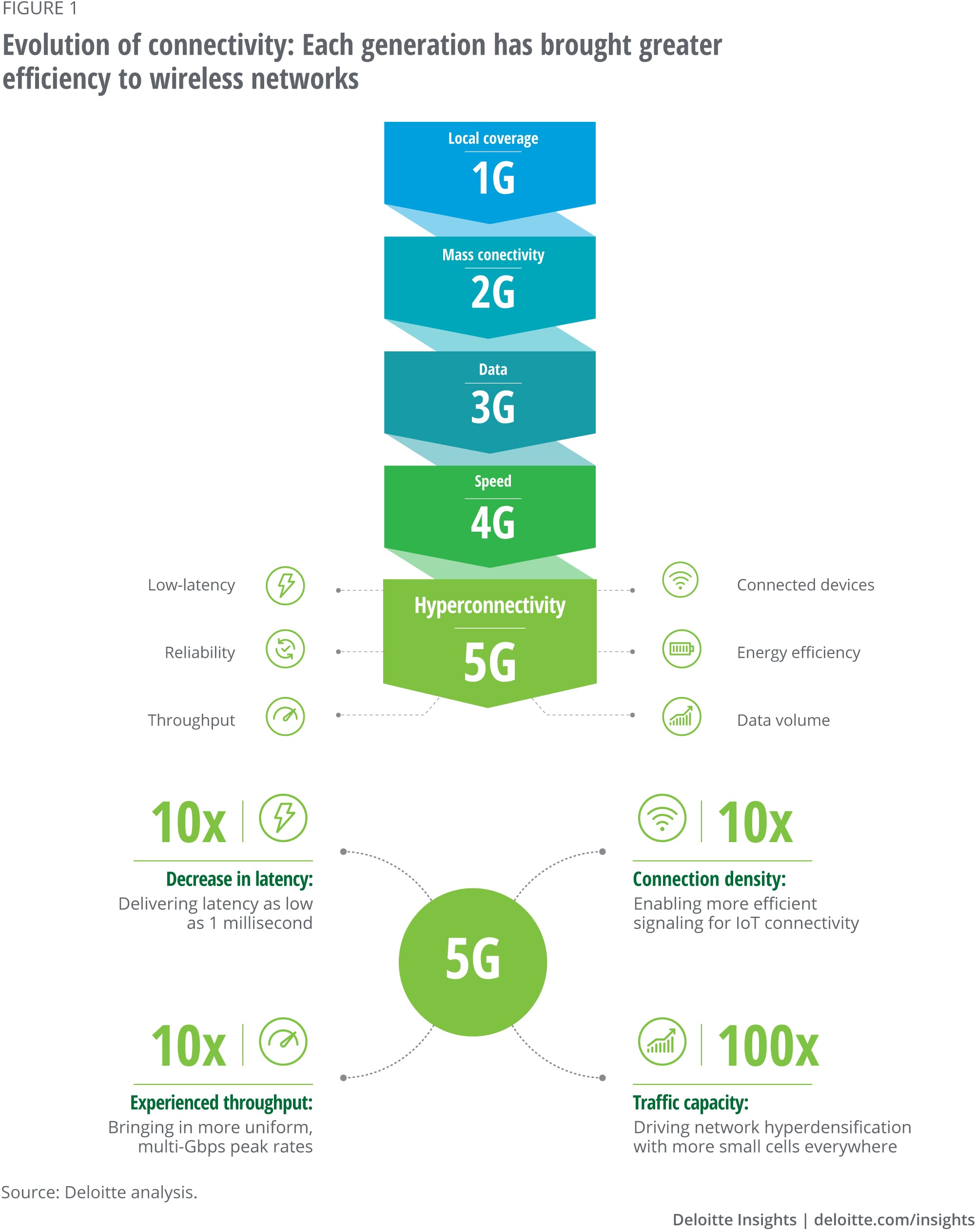
Not just enhanced speeds. While much of the excitement around 5G technology focuses on its promise of enhanced speeds (from 1 to 20 Gbps), it isn’t simply a faster version of 4G. Its improvements in reliability and latency can provide numerous benefits, including ubiquitous internet access, real-time remote access to enterprise applications, precise location-sensing, device-to-device communication, and real-time insights.
Transformed visual experience. Much of the conversation around 5G has focused on consumer applications such as streaming videos, gaming, augmented reality (AR), virtual reality (VR), and mixed reality (MR). The ability to provide rich visual experiences through 5G at scale could revolutionize the way content providers interact with consumers.
Multiuser experience. 5G can also enable multiuser applications such as military training simulations and remote control of multiple robots in warehouses and industrial environments.
Hyperconnected cities. 5G’s ability to support massive device density allows “things” to be connected with a high degree of repeatability and reliability. For instance, today’s smart cities might have sensor networks of a few thousand connected devices. Imagine a scenario where millions of such devices can be connected in a city center, measuring temperature, humidity, air quality, flood levels, pedestrian traffic, and more.
An autonomous future. 5G’s low latency and enablement of new technologies such as MEC can support a multitude of activities in the next decade, including autonomous vehicles, urban air mobility, and smart ports.
Three 5G use case categories and their implications for government
Government officials and policymakers are focusing on how 5G can enhance their operations. In 5G parlance, these are called use case categories or functionalities. 5G-enabled use cases fall into three general categories, as defined by the 3rd Generation Partnership Project (3GPP), a partnership of organizations that develop global telecommunication standards.7
- Enhanced mobile broadband (eMBB): Allows for massive improvements in connection speeds, supporting speeds 10 to 20 times faster than today’s 4G.
- Ultra-reliable low-latency communications (uRLLC): Provides high reliability and low latency, reducing the time needed to send a signal and receive a response to 10 milliseconds or less.8
- Massive machine-type communication (mMTC): Enables a “connected everything” future by supporting device densities of 1 million per square kilometer, versus 4G’s maximum of 100,000.9
Depending on the evolution of 5G technology and capabilities, adoption challenges, and economies of scale, some use case categories will be deployed sooner than others (figure 2). For example, eMBB might be the first category deployed, especially in dense urban areas, as carriers focus on revenue with an early rollout and device manufacturers focus on 5G-enabled smartphones. But these use case categories complement one other and all will be required to achieve the full benefits of 5G.
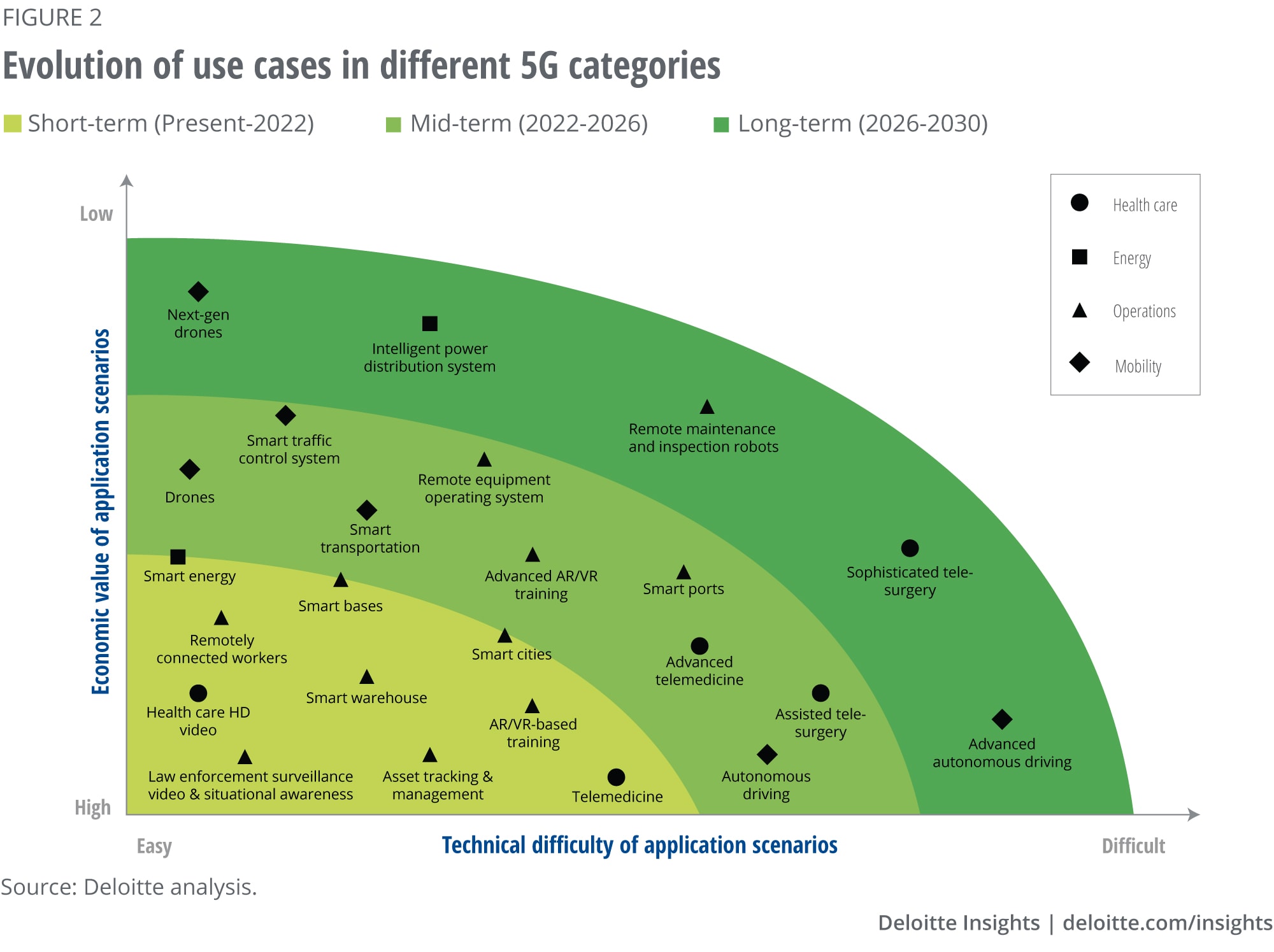
eMBB: Real-time information for field workers
eMBB can handle 10 times more traffic than previous generations, a massive improvement for the streaming of videos and other visual content on mobile devices. It can also, for instance, stream high-definition video footage, maintain connection, and enable transmission from vehicles traveling as fast as 300 miles per hour.10
For government, the impact of eMBB is likely to be felt mostly in the field. The convergence of AI, cloud/MEC computing, and 5G could allow government to reimagine how field workers perform their jobs. Imagine, for instance, streaming a high-definition video, downloading a large file from a remote server, and using a navigation app on a mobile device simultaneously, while in a moving vehicle. We can even extend this example to military personnel using a navigation app on a mobile device, accessing data in real time from field sensors, while driving a vehicle. That’s simply impossible today, but 5G can make it happen.
And consider its effects on digital reality (AR, VR, and MR). This content will require a continuous stream of immersive high-resolution video, audio, and even tactile feedback to be transmitted to both stationary and mobile consumers (figure 3).
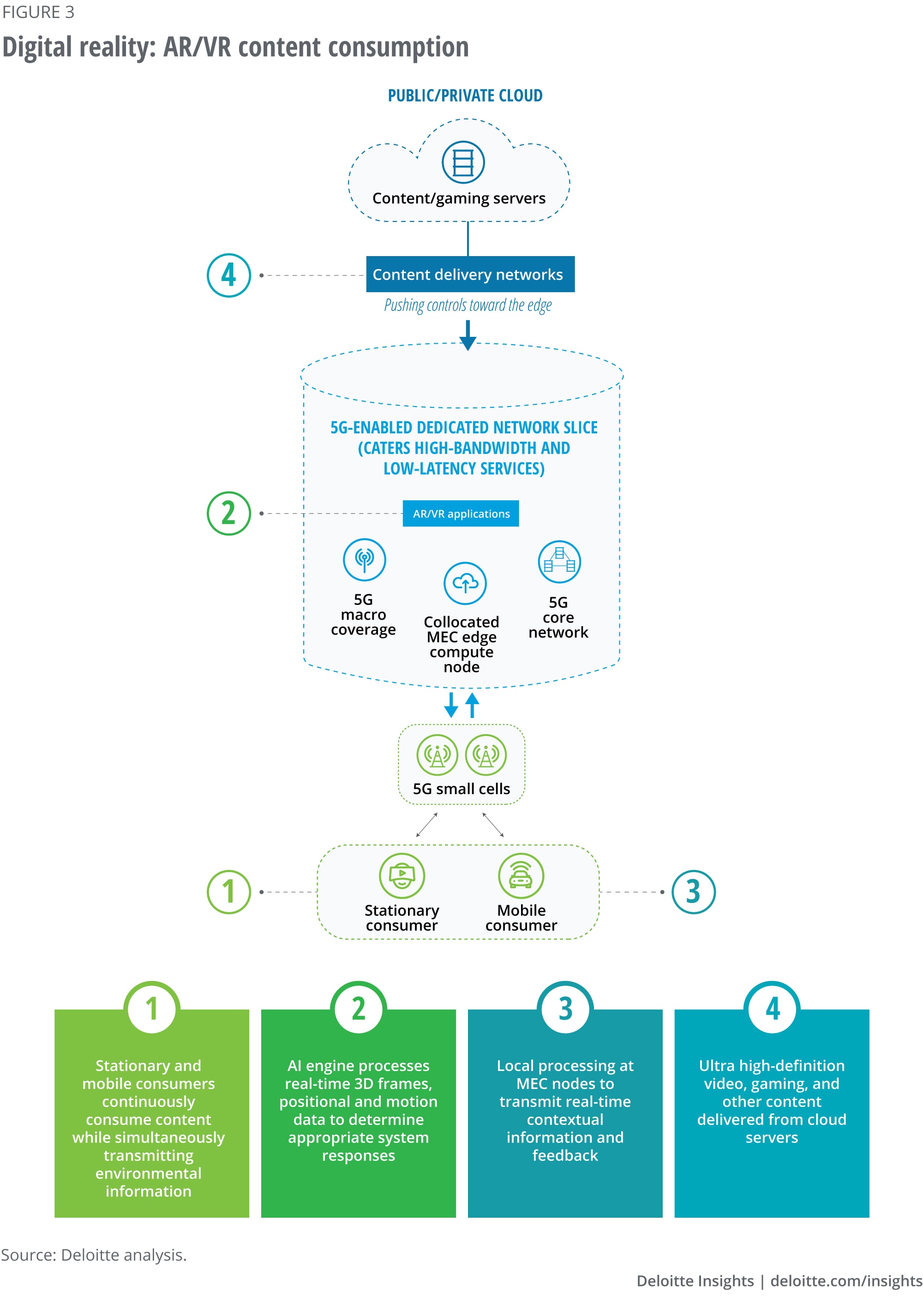
Some important use cases for government field workers include:
- Law enforcement officers, using a combination of MEC and AI, would be able to capture, relay, and analyze live data streams in real time, providing them with information for critical decisions.
- Human services caseworkers can be equipped with a 5G-enabled mobile device, AR glasses, and body cameras during client field visits, particularly for children in need. This would provide relevant information about a neighborhood, including distances to parks, bus and metro stations, information on nearby schools, and recent crime data, to help them judge the suitability of a child’s living arrangements.
- Postal services workers can track shipments, packages, and vehicles precisely from anywhere within a city, enhancing their ability to schedule deliveries and anticipate delays in real time, thus improving customer experience.11
uRLLC: Doing the previously impossible
uRLLC is one of 5G’s major breakthroughs, as it enables previously impossible applications. Its most important characteristic is its enablement of ultra-reliable, ultraresponsive connections with latencies as low as 1 millisecond (ms). It takes 13ms for an image seen by the human eye to be processed by the brain; anything less than that can be deemed “instant.”12 Ultra-low-latency 5G also offers the promise of “six nines,” or 99.9999% reliability.13
Low latency combined with high reliability can support mission-critical systems that can’t afford delay or error, including remote surgery and connected autonomous vehicles (although onboard sensors and connectivity would work as complementary technologies in a government motor fleet). For a Veterans Affairs or military doctor performing a critical surgery remotely, even a few seconds of disconnection could be catastrophic—as it could for an autonomous vehicle on a highway.
Such use cases are likely to take the longest to see ubiquitous deployment. Due to high infrastructure costs, it may be difficult to scale this category over a wide area during the early years of 5G. In the near term, however, ultra-low-latency 5G could be deployed in densely trafficked urban areas such as stadiums and train stations, or through campus-like deployments at manufacturing plants, warehouses, ports, and military bases.
One of the most talked-about examples in this category is the connected car, particularly assisted driving and autonomous vehicles (figure 4). A connected-car future requires coordination among vehicles moving at high speed and between vehicles and traffic infrastructure. To achieve near-instantaneous decision-making (for collision avoidance), the processing infrastructure must reside close to the endpoints—the vehicles and infrastructure—which will require a MEC-based communication architecture.
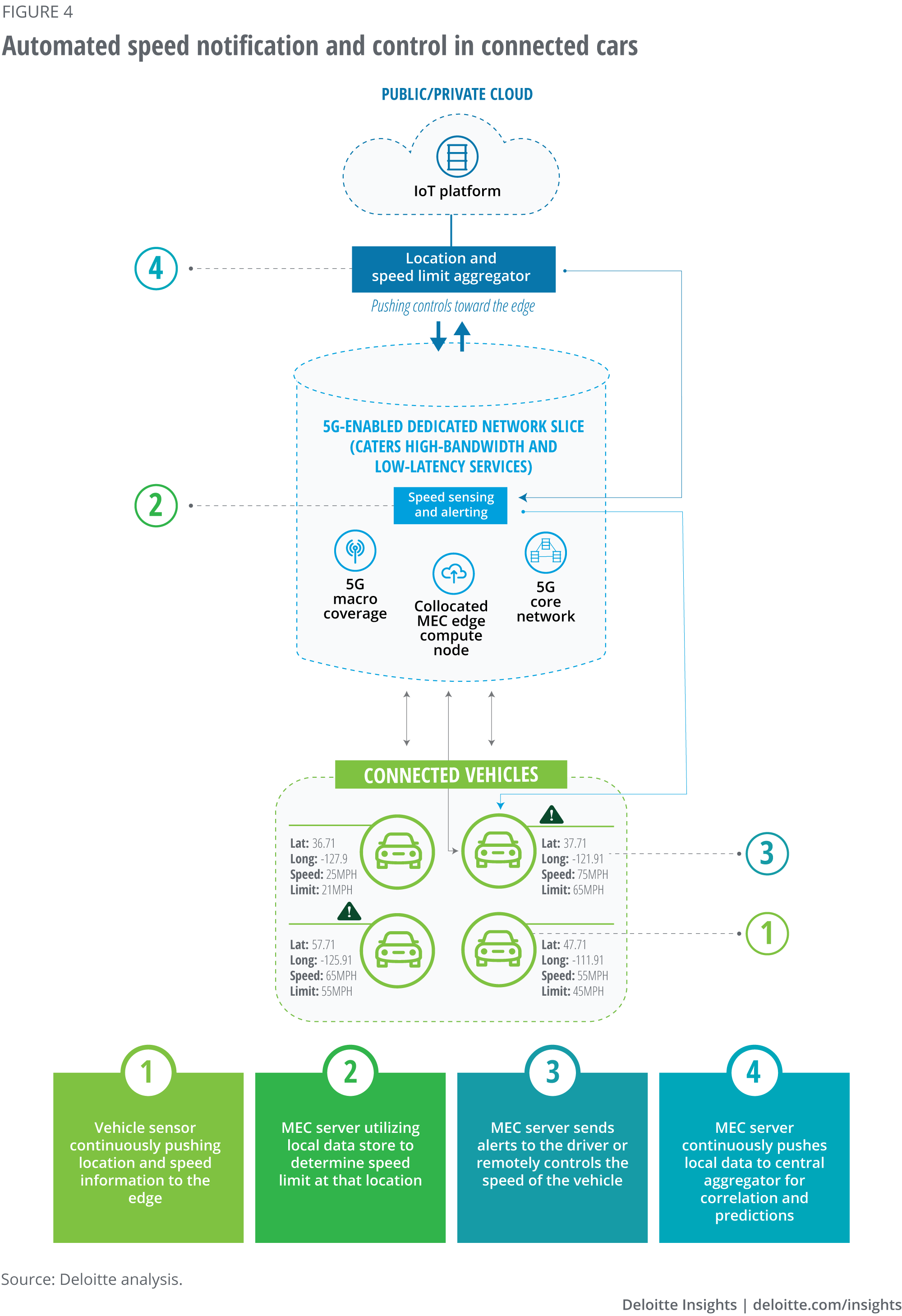
Some important governmental use cases for uRLLC include:
- Smart ports. We’ve already seen some early deployments of ultra-low-latency 5G; carriers are working with port authorities and governments to install 5G test beds. In these examples, 5G is creating a connected port ecosystem that supports automated cargo handling, directs ship traffic, improves safety, and manages energy use.14 A command center can use powerful AI tools to crunch data from camera feeds, sensors, and incoming ships to prioritize cargo offloading and make the optimum use of space in container storage.
- Smart military bases. Military bases are in essence small cities, and they can use 5G in many of the same ways, driving advances in interbase autonomous transit, base security, and personnel services. As with ports, a network of high-definition cameras, “internet of things” (IoT) devices, and sensors could provide real-time data on perimeter security, asset management, and mission-critical systems.15 A 5G-enabled smart base also could benefit military families by providing better educational resources for military spouses and children, telemedicine services, and more.
- Remote surgery. 5G capabilities can broaden the health care system’s capacity and make it more accessible to rural communities. In an early experiment in China, robots conducted some parts of orthopedic surgeries while doctors controlled them remotely from another city.16 Advances in 5G and AI could open multiple remote surgery application areas in rural health care, veteran health, and combat medicine.
mMTC: Building a hyperconnected future
mMTC could usher in an era of hyperconnectivity. As noted earlier, it can support massive numbers of connected devices—everything from environmental sensors to traffic cameras to IoT devices in buildings—effectively removing past limitations on the number of connected devices in a given area. As IoT devices continue to proliferate and network efficiencies enable longer battery life, the ability to support higher device densities becomes increasingly important.17 In addition, advances in edge computing technology will give further impetus to the “connected everything” future.
mMTC has huge implications for the ability to create hyperconnected smart communities. Cities, ports, warehouses, and more will be able to embed sensors across the infrastructure, including pavements, buildings, traffic signals, water and sewage pipelines, and mass transit. Cities already have embedded sensors in public infrastructure in a relatively limited way; 5G can support millions of such connected devices, even within small geographical areas, enabling a new era of public sector infrastructure management and maintenance.
The concept of a “safe building” (figure 5) is a good example that would require mMTC. Data from numerous sensors within a building, including fire and smoke detection, ambient temperature, audio and pressure readings in gas pipes, could be coupled with closed-circuit television and 3D positioning systems to provide a comprehensive view of the building’s safety and integrity to its managers, detecting, for instance, a fire threat in a single room or closet. This concept will require simultaneous communication from thousands of sensors per building and millions across a single city block.
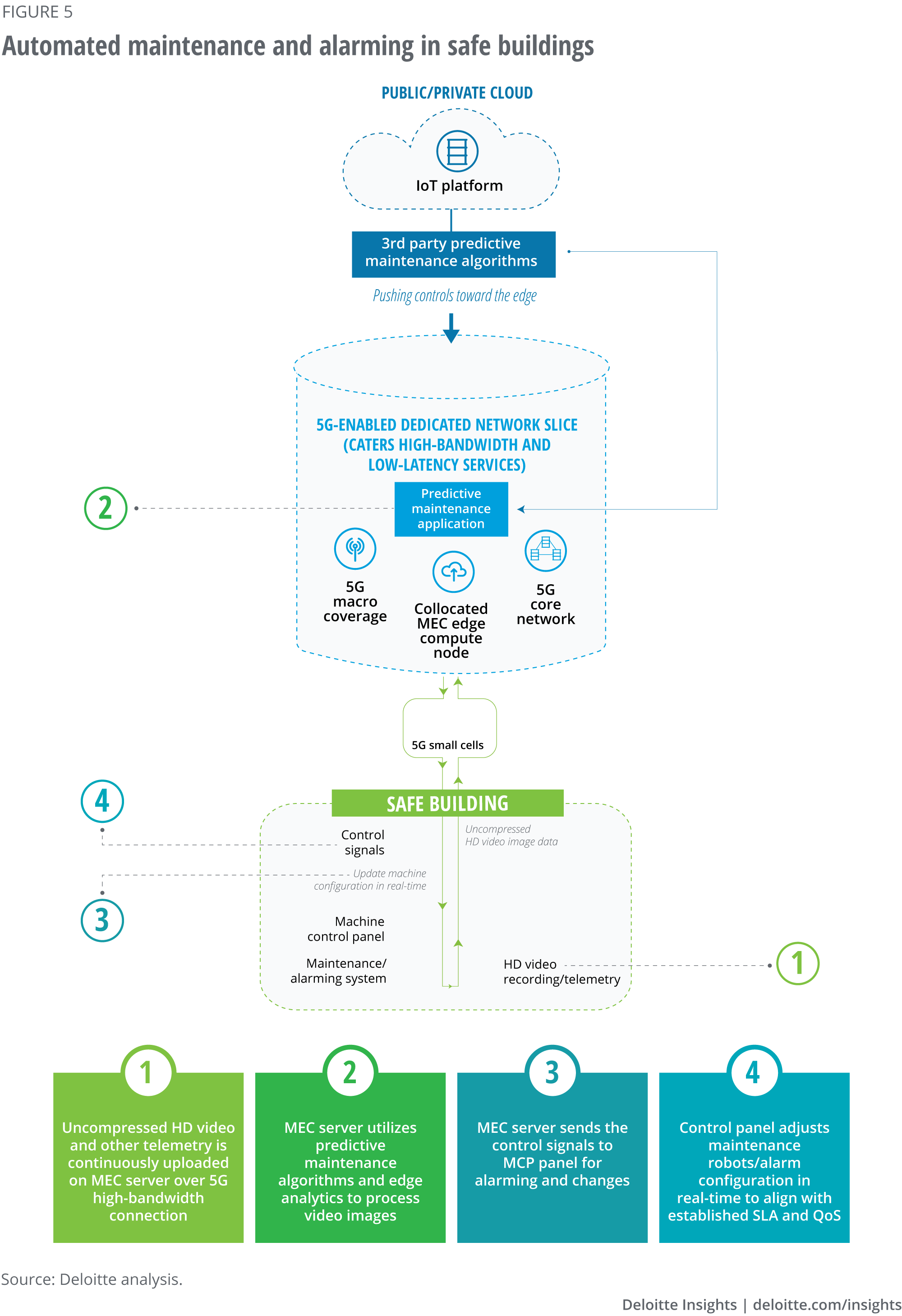
mMTC can enable multiple use cases in government, including:
- Public works, which could be reimagined in a 5G era. Today, for example, when a public works department must dig up roads, it relies on blueprints and underground infrastructure maps. Public assets, including power lines, drainage pipes, optic fibers, and gas pipelines, could be embedded with IoT sensors. With a mix of 5G wireless and wireline connectivity, public works departments could visualize the exact location of assets in every part of the city. The same sensors would provide real-time information on leakages and blockages and help the department identify problems before they become serious, allowing for efficient resource allocation.
- Smart health monitoring could be of particular interest in the post-COVID-19 world. For example, 5G can enable the use of large-scale, no-contact body temperature measurements of people at a short range, with this passively collected data being transmitted to a data center for further analysis. Such a use case could be deployed to improve remote health monitoring capabilities in hospitals, airports, and even workplaces. Of course, any such monitoring applications would need to address data privacy concerns, including data security risks.
The convergence of 5G use cases
These examples provide a high-level perspective on how the underlying technologies differ. Many use cases will fall under more than one category, however, requiring multiple technologies for effective implementation.
Consider the example of 5G-enabled first responders. Massive amounts of data, generated through high-resolution cameras, wearables, and embedded sensors, can provide situational awareness. This data will either be transmitted back to a command center or processed on site using advances in edge computing. The responder will receive a steady stream of the most important and relevant information to make critical decisions on the go. All three 5G functions would work in tandem to provide mission-critical insights to responders, including high-resolution video feed (using eMBB), integrated infrastructure sensor data (using mMTC), and near-instantaneous actionable information (through uRLLC).
The journey toward ubiquitous 5G: Seven considerations for government leaders
5G can catalyze national competitiveness and transform government operations. But the transformation won’t happen overnight, and could involve significant policy issues.
These issues largely fall into two broad categories:
Infrastructure
- Modifications to existing network infrastructure, systems, and applications
- Cloud integration
- Network security and supply chain vulnerabilities
Public policy and government operations
- Data ethics and privacy
- Long-term spectrum policy
- Urban-rural connectivity divide
- Workforce implications
Infrastructure considerations
Modifications to existing network infrastructure, systems, and applications
The most immediate task for public agencies will be the integration of 5G services and infrastructure with existing systems. In addition, they should assess and address gaps in their current application ecosystems.
There would be a need to upgrade public IT infrastructure and applications to take advantage of 5G technology and adopt new use cases. For example, first-responder devices and local communication infrastructure would need upgrades to enhance disaster management response in the 5G era. This will involve redesigning and redeveloping systems and applications for specific use cases.
Cloud Integration
Cloud computing has changed our everyday life, allowing us to access files remotely for work, upload and download documents from secure cloud environments, watch videos on the go, listen to music, and access maps and digital assistants. And it’s only going to expand and improve with 5G connectivity.
Governments should consider multiple factors to integrate 5G and the cloud:
Choose the right cloud adoption model. A critical aspect of cloud adoption is the decision to “build or buy”—whether to build your own cloud platform or to buy cloud services from a provider. Government agencies will have to justify the significant time, effort, and skills needed to develop and operate in-house cloud platforms, or move some applications and processes to public, private, or hybrid clouds.
Protect sensitive data. Additionally, it’s important to consider where data will reside in a chosen cloud approach—where centers hosting data and applications will be located physically. Depending on an agency’s specific requirements (e.g., sensitive data cannot reside outside the United States; state-specific data must reside within the state), different approaches may be needed. Moreover, broader cloud adoption may give rise to skills gaps in the government workforce.
Network security and supply chain vulnerabilities
Two prominent US federal reports on 5G have been released in the past year, one by the Defense Innovation Board and the other by the Department of Homeland Security.18 Both acknowledge that 5G will be transformational; both warn about potential vulnerabilities and security risks. The reports focus on two specific areas of risk: supply chains and network security.
Supply chain risks. Because 5G development is happening around the world, it would be difficult for US agencies to avoid supply chain risks. For instance, they may procure 5G components, software, and hardware from trusted commercial entities, but may have little insight or control over vendors’ supply chains. While these risks may be controlled by standards such as the recently introduced Cybersecurity Maturity Model Certification, in the near term, the risk of flawed or counterfeit components and malicious software creeping into supply chains remains high.19
Network security risks. Network security issues may be further accentuated in the 5G era due to the virtualization of networks and the anticipated proliferation of network nodes. Risks could originate from poor software development methods, nonadherence to software patches by the government or by vendors, transmission of malware during maintenance operations, and much more. However, as 5G implementation evolves and matures, it is expected to result in stronger security as technologies such as network virtualization, MEC, and network slicing can make networks more secure. But the short-term network security risks remain.
Exponential rise in threat vectors. 5G may greatly increase opportunities for malicious actors, given the proliferation of cell towers, thousands of small cells, and millions of mobile and IoT devices. It’s been demonstrated that small cells can be hacked and used to intercept data and messages from any mobile device connected to the cell.20 5G can support a zero-trust security model, which is critical given the enormous number of connected devices. A zero-trust architecture that leverages 5G can prevent lateral data movement within the network by identifying, monitoring, and authenticating all devices, enabling high levels of security.
Public policy and government workforce considerations
Data ethics and privacy
Especially in urban areas, 5G is likely to be deployed with ever-increasing numbers of cameras and sensors, each with large associated data sets. Add to this advances in AI, including facial recognition, and intense surveillance capabilities become possible.
Law enforcement has a legitimate interest in using 5G for surveillance. At the same time, however, the ability spurs concerns about the ethical use of these technologies, including privacy issues and civil liberties protection. In the United States, some state and local jurisdictions are already passing laws that limit the use of facial recognition software.21
The growing debate around data and AI ethics goes far beyond law enforcement. IoT devices can track an astounding amount of data about a person, from their physical location and daily habits to every keyboard click. Combined with AI, this ability makes data ethics a significant policy debate, particularly since existing laws define so little.22
The right safeguards will be essential to prevent unintended consequences such as data leakage or theft, the hacking of private health care data, or the sale of personal data without the consumer’s consent. Governments have a role in establishing these safeguards, by creating privacy standards and providing regulations for data protection.
Long-term spectrum policy
All wireless communications use sections of the electromagnetic spectrum. Since the advent of radio, this spectrum has been a key part of wireless communications. The spectrum today is used by radio, television, cell phones, global positioning systems (GPS), and more.
The spectrum debate gets very technical very quickly and goes beyond the scope of this paper. But government officials should know that spectrum choices have implications for performance, geographic coverage, infrastructure, partners, and equipment. Each spectrum band has different characteristics:
- Low band (under 3GHz) travels long distances with minimal signal interruption and with better building penetration. Today’s wireless networks are built primarily on the low-band spectrum.
- High band (above 24 GHz) travels shorter distances—meters, not miles—and cannot easily penetrate objects such as buildings, but offers high capacity and ultra-fast speeds.
- Mid band (between 3 GHz and 24 GHz) blends the characteristics of both low- and high-band spectrum, providing a mix of coverage and capacity.23
Many Asian nations are already employing the mid-band spectrum for 5G, and manufacturers are developing devices for use in this band, thereby lowering costs for these countries through economies of scale. If the United States chooses other frequency bands, it won’t enjoy the same cost advantages.
In addition, governments should consider which parts of the spectrum they’re already using. For example, some frequencies are designated for national defense and satellite communications, while other agencies employ 24 GHz and other specific ranges for weather satellite communications. In the future, such frequencies may either need to be reserved for existing functions or shared.
Urban-rural connectivity divide
The proper role of state and local governments in encouraging the advancement of 5G is hotly debated, particularly in relation to rural connectivity. The case for 5G in urban settings typically rests on two critical factors:
- Economics: The sheer number of consumers allows telecommunication companies to spread their costs.
- Infrastructure: 5G would require small cells, a vast amount of optical fiber, and computing capabilities very close to the network edge.24
But the logistics of providing 5G in densely populated urban settings are far different from those for rural, sparsely populated and mountainous areas.
5G could be an effective alternative or complementary technology to direct last-mile fiber connectivity in rural areas. While substantial investments in fiber could deliver comprehensive rural 5G connectivity in the United States, such a massive volume of fiber network will take significant time (almost a decade or two) and resources to complete. Instead, government could consider deploying long-haul fiber routes to specific points in rural areas, where 5G towers would complete the link to individual homes and businesses.
In the future, however, new technologies could be a part of the solution. For instance, low-earth-orbit (LEO) satellites could be combined with rural broadband and 5G connectivity in a complementary fashion. More than 700 satellites are expected to be in LEO by the end of 2020, up from just 200 in 2019. The combination of advancements in satellite manufacturing, the falling costs of orbital launches, and growing demand could make connectivity via LEO satellites with 5G feasible in isolated areas, including rural and mountainous regions and even in bodies of water.25
At the local level, city governments need to work with carriers, utility companies, and infrastructure services to deploy 5G infrastructure effectively, as it’s likely to require numerous small cell towers.
Workforce implications
5G can connect us as individuals, both personally and professionally, like never before. Such hyperconnectivity offers many potential advantages—from a health perspective, as virtualization increases and health care moves closer to the person, and for business and industry, as new systems aid employees in gathering, analyzing, and using data and allowing multiple users to enjoy deeply immersive training simultaneously.
Automation and AI can aid humans in processing all this information. But what will the flood of data mean for us? Would it free up time for other activities, or lead to employee burnout? 5G raises important questions about the future of government workforce, including training, reskilling, and upskilling.
Starting the journey
The advent of 5G offers governments tremendous potential for improving their operations. At the same time, it would require government officials to develop new use cases, assess and prepare existing networks for 5G, develop broader cybersecurity strategies, and much more. And patience will be required, as these changes won’t happen overnight.
While much remains uncertain about 5G’s specific applications, officials who embrace this topic quickly can be in the best position to understand how government can tap into 5G’s potential benefits. Now is the time to begin the journey.
Appendix: Understanding 5G’s foundational elements
To make sound decisions about 5G, government leaders should have a strong understanding of the basic principles of this technology. 5G will be driven by the various foundational elements, residing/applicable across different parts of the telecom network (figure 6), that are dependent upon each other to achieve its intended benefits (figure 7).
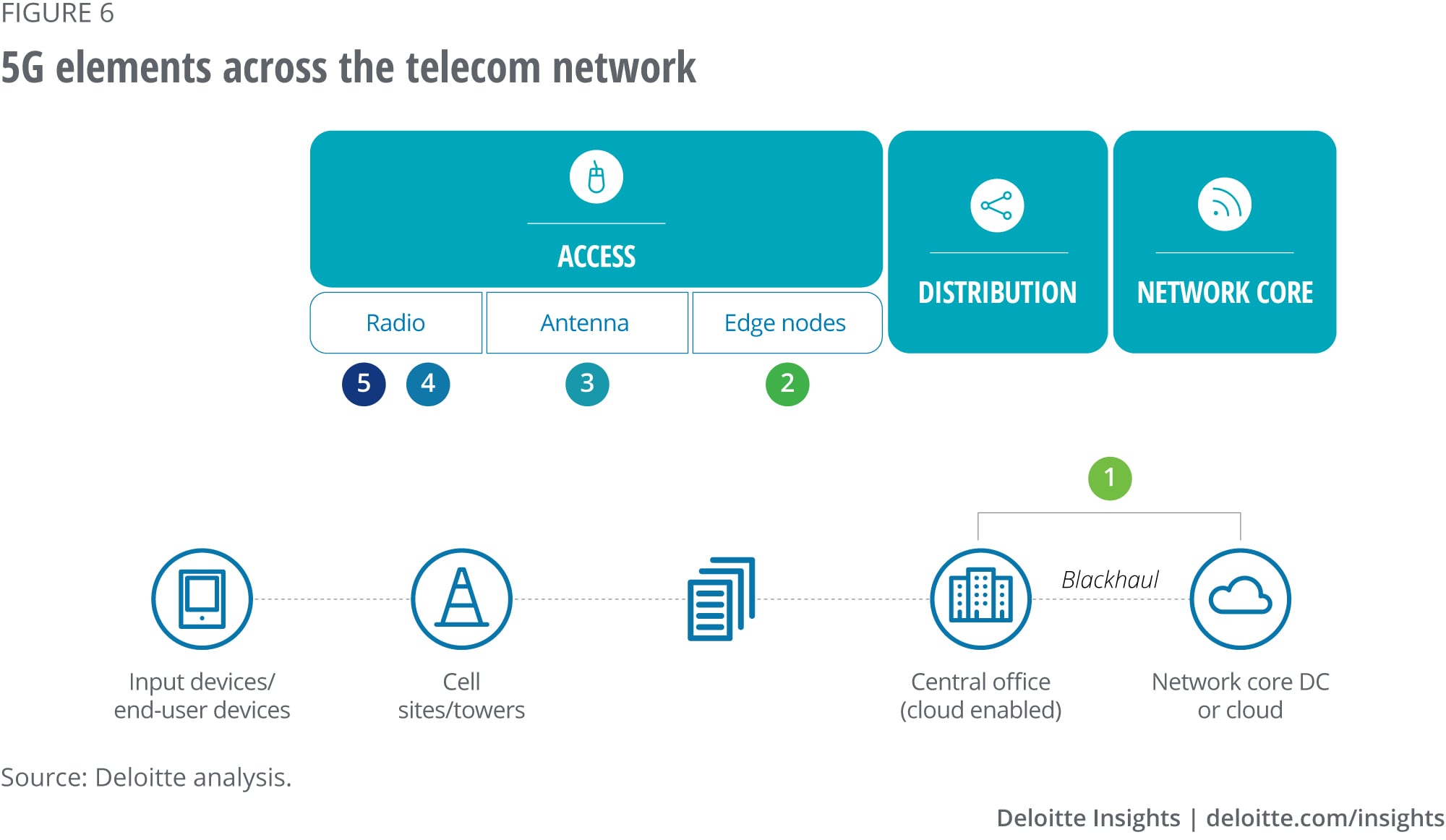
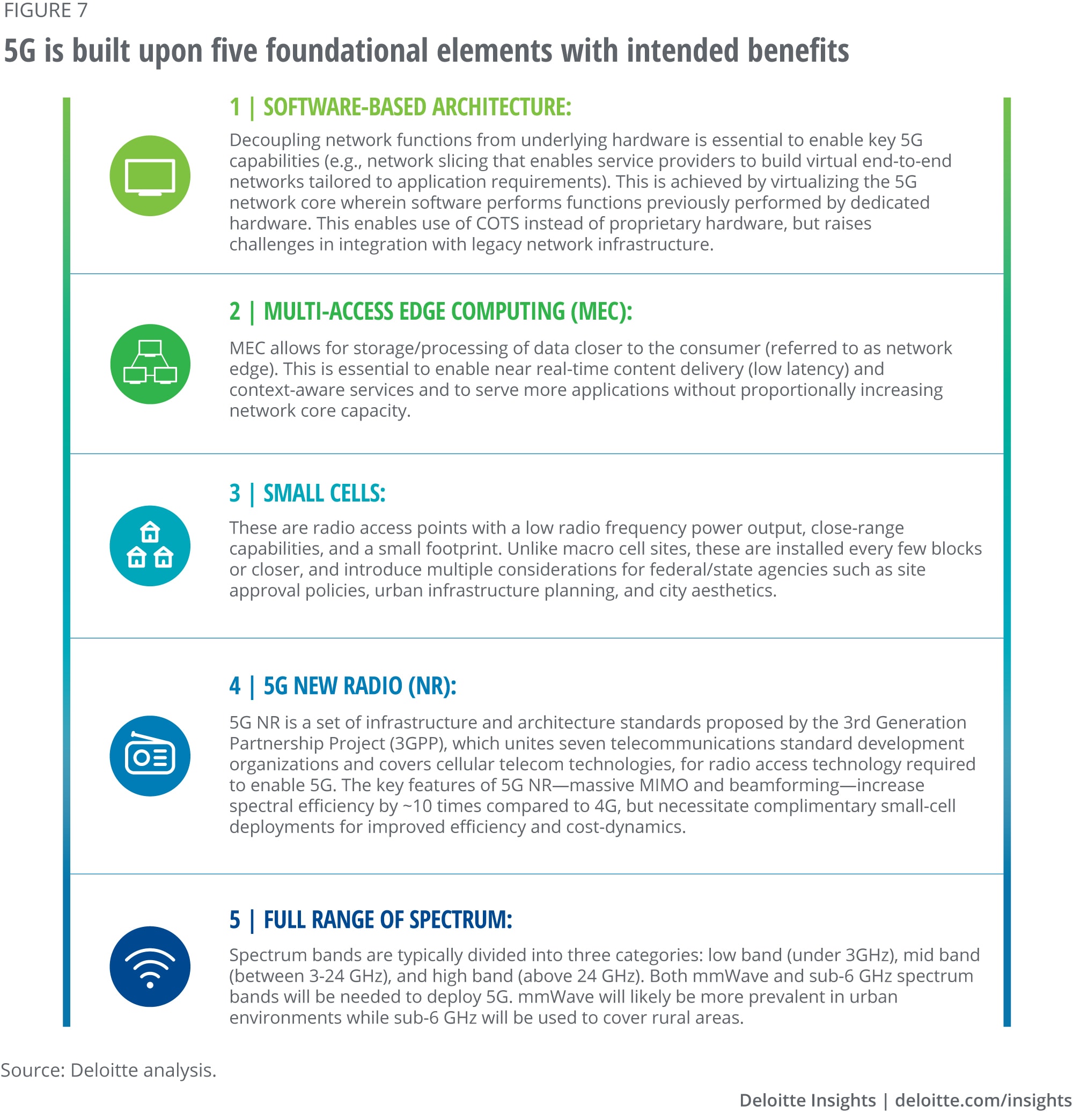
These foundational elements and technology enhancements come together to deliver the unique capabilities that define 5G (figure 8). The network capabilities required for the enablement of next-gen use cases can be realized with a combination of one or more technology features under the 5G umbrella.
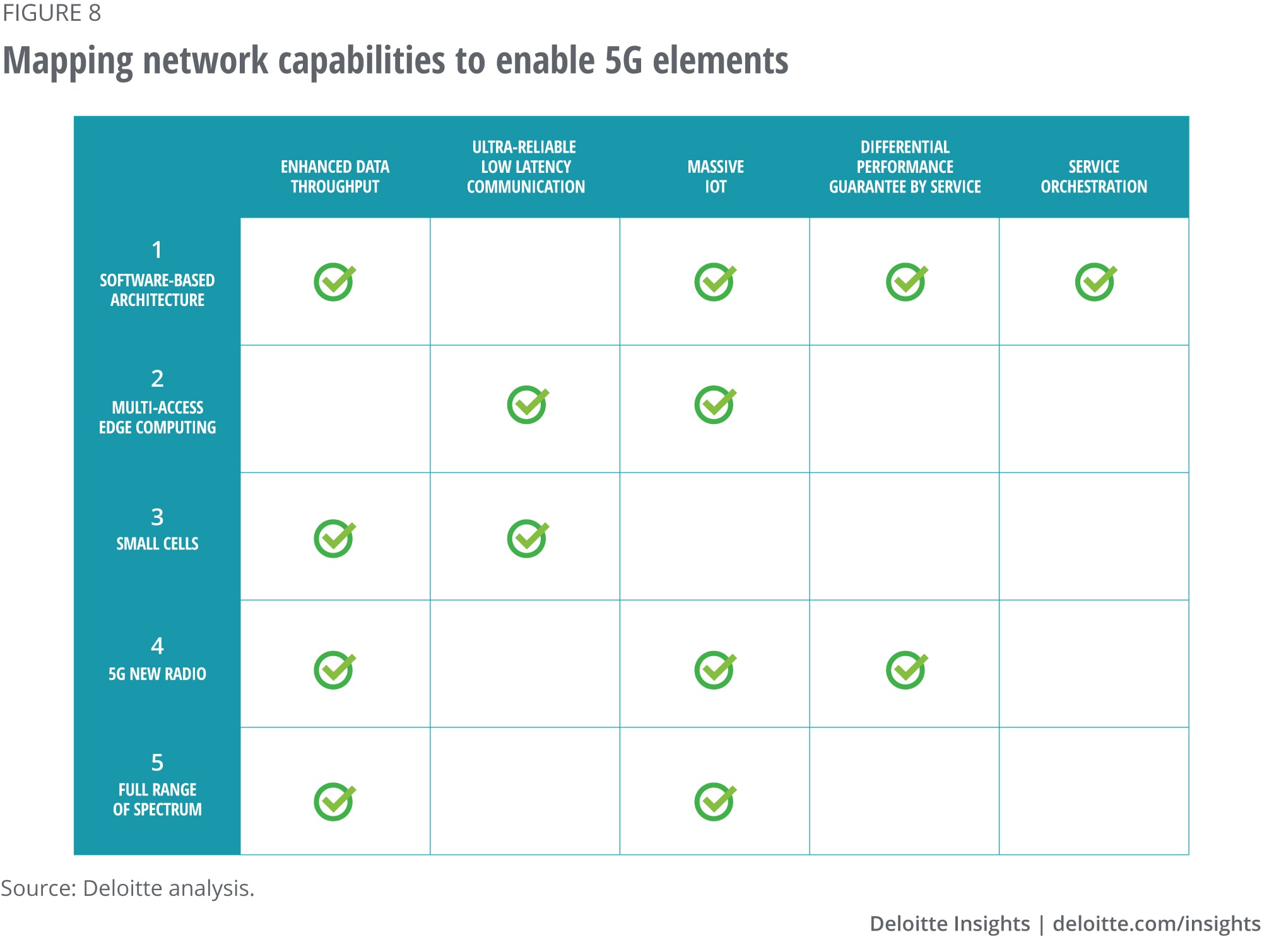
5G architecture would dramatically change the way information is carried and managed. Over a 5G network, data is sent separately from its routing instructions; devices communicate with numerous points on the network and on numerous frequencies (unlicensed and licensed); and data is only reassembled at the device. This is a shift as transformational as the move from traditional IT architecture to cloud computing, and to have at least a basic understanding of the underlying technology is important for those who are designing, building, operating, and securing the network as well as those communicating over the network.
© 2021. See Terms of Use for more information.
Explore technology in government
-
Future of government Collection4 years ago
-
Convergence of technology in government Article5 years ago
-
AI readiness for government Article5 years ago
-
Private 5G networks: Enterprise untethered Article5 years ago
-
Government cloud: A mission accelerator for future innovation Article6 years ago
-
Government & Public Services Collection











